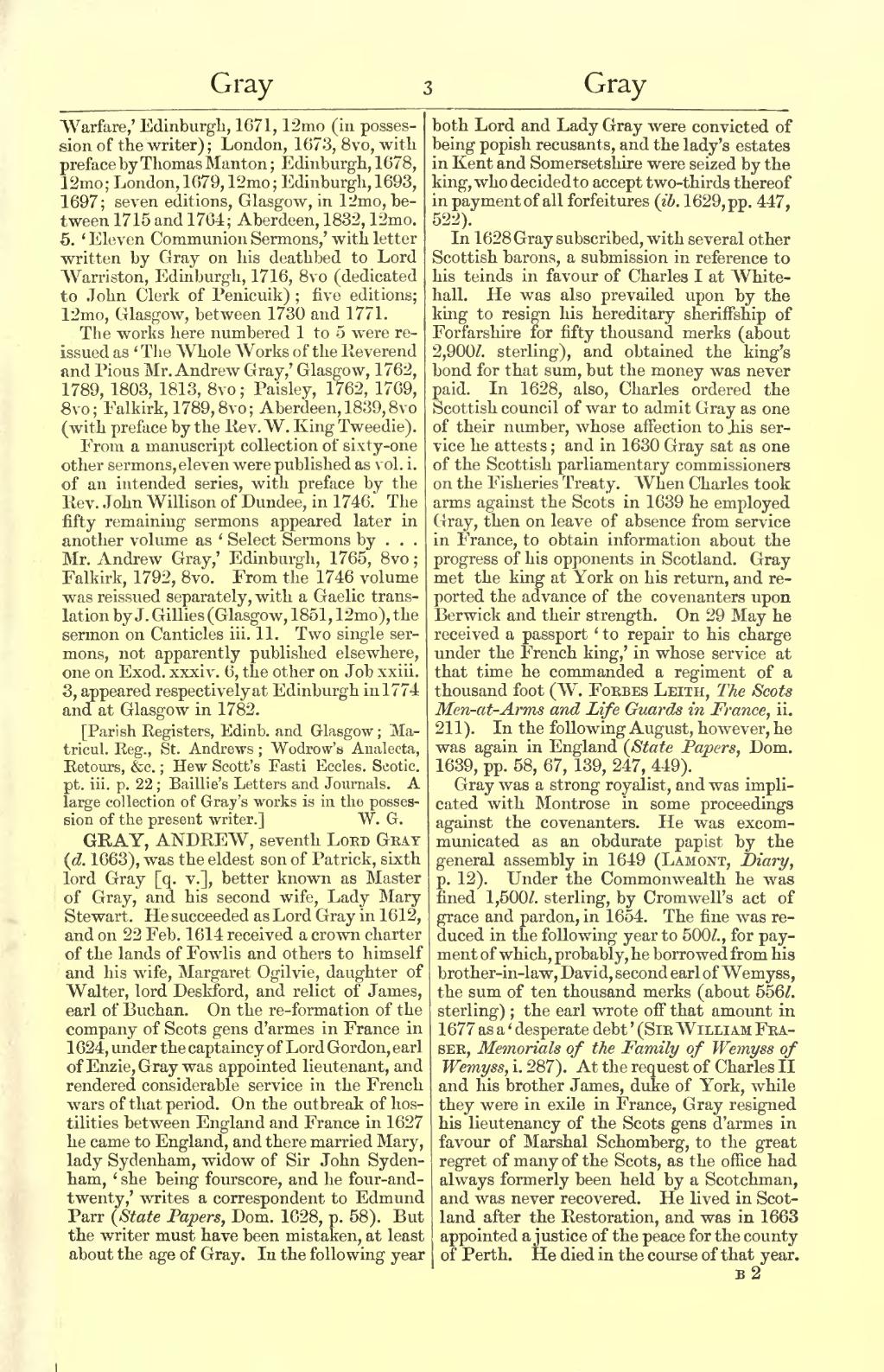Warfare,’ Edinburgh, 1671, 12mo (in possession of the writer); London, 1673, 8vo, with preface by Thomas Manton; Edinburgh, 1678, 12mo; London, 1679, 12mo; Edinburgh, 1693, 1697; seven editions, Glasgow, in 12mo, between 1715 and 1764; Aberdeen, 1832, 12mo. 5. ‘Eleven Communion Sermons,’ with letter written by Gray on his deathbed to Lord Warriston, Edinburgh, 1716, 8vo (dedicated to John Clerk of Penicuik); five editions, 12mo, Glasgow, between 1730 and 1771.
The works here numbered 1 to 5 were reissued as ‘The Whole Works of the Reverend and Pious Mr. Andrew Gray,’ Glasgow, 1762, 1789, 1803, 1813, 8vo; Paisley, 1762, 1769, 8vo; Falkirk, 1789, 8vo; Aberdeen, 1839, 8vo (with preface by the Rev. W. King Tweedie).
From a manuscript collection of sixty-one other sermons, eleven were published as vol. i. of an intended series, with preface by the Rev. John Willison of Dundee, in 1746. The fifty remaining sermons appeared later in another volume as ‘Select Sermons by … Mr. Andrew Gray,’ Edinburgh, 1765, 8vo; Falkirk, 1792, 8vo. From the 1746 volume was reissued separately, with a Gaelic translation by J. Gillies (Glasgow, 1851, 12mo), the sermon on Canticles iii. 11. Two single sermons, not apparently published elsewhere, one on Exod. xxxiv. 6, the other on Job xxiii. 3, appeared respectively at Edinburgh in 1774 and at Glasgow in 1782.
[Parish Registers, Edinb. and Glasgow; Matricul. Reg., St. Andrews; Wodrow's Analecta, Retours, &c.; Hew Scott's Fasti Eccles. Scotic. pt. iii. p. 22; Baillie's Letters and Journals. A large collection of Gray's works is in the possession of the present writer.]
GRAY, ANDREW, seventh Lord Gray (d. 1663), was the eldest son of Patrick, sixth lord Gray [q. v.], better known as Master of Gray, and his second wife, Lady Mary Stewart. He succeeded as Lord Gray in 1612, and on 22 Feb. 1614 received a crown charter of the lands of Fowlis and others to himself and his wife, Margaret Ogilvie, daughter of Walter, lord Deskford, and relict of James, earl of Buchan. On the re-formation of the company of Scots gens d'armes in France in 1624, under the captaincy of Lord Gordon, earl of Enzie, Gray was appointed lieutenant, and rendered considerable service in the French wars of that period. On the outbreak of hostilities between England and France in 1627 he came to England, and there married Mary, lady Sydenham, widow of Sir John Sydenham, ‘she being fourscore, and he four-and-twenty,’ writes a correspondent to Edmund Parr (State Papers, Dom. 1628, p. 58). But the writer must have been mistaken, at least about the age of Gray. In the following year both Lord and Lady Gray were convicted of being popish recusants, and the lady's estates in Kent and Somersetshire were seized by the king, who decided to accept two-thirds thereof in payment of all forfeitures (ib. 1629, pp. 447, 522).
In 1628 Gray subscribed, with several other Scottish barons, a submission in reference to his teinds in favour of Charles I at Whitehall. He was also prevailed upon by the king to resign his hereditary sheriffship of Forfarshire for fifty thousand merks (about 2,900l. sterling), and obtained the king's bond for that sum, but the money was never paid. In 1628, also, Charles ordered the Scottish council of war to admit Gray as one of their number, whose affection to his service he attests; and in 1630 Gray sat as one of the Scottish parliamentary commissioners on the Fisheries Treaty. When Charles took arms against the Scots in 1639 he employed Gray, then on leave of absence from service in France, to obtain information about the progress of his opponents in Scotland. Gray met the king at York on his return, and reported the advance of the covenanters upon Berwick and their strength. On 29 May he received a passport ‘to repair to his charge under the French king,’ in whose service at that time he commanded a regiment of a thousand foot (W. Forbes Leith, The Scots Men-at-Arms and Life Guards in France, ii. 211). In the following August, however, he was again in England (State Papers, Dom. 1639, pp. 58, 67, 139, 247, 449).
Gray was a strong royalist, and was implicated with Montrose in some proceedings against the covenanters. He was excommunicated as an obdurate papist by the general assembly in 1649 (Lamont, Diary, p. 12). Under the Commonwealth he was fined 1,500l. sterling, by Cromwell's act of grace and pardon, in 1654. The fine was reduced in the following year to 500l., for payment of which, probably, he borrowed from his brother-in-law, David, second earl of Wemyss, the sum of ten thousand merks (about 556l. sterling); the earl wrote off that amount in 1677 as a ‘desperate debt’ (Sir William Fraser, Memorials of the Family of Wemyss of Wemyss, i. 287). At the request of Charles II and his brother James, duke of York, while they were in exile in France, Gray resigned his lieutenancy of the Scots gens d'armes in favour of Marshal Schomberg, to the great regret of many of the Scots, as the office had always formerly been held by a Scotchman, and was never recovered. He lived in Scotland after the Restoration, and was in 1663 appointed a justice of the peace for the county of Perth. He died in the course of that year.
